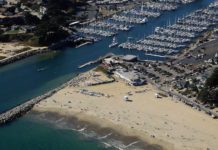
It’s been a rough week for most Santa Cruz county citizens. However, difficult evacuations were slightly easier for UCSC students and staff by due to proactive caution and communication. The University managed to evacuate all 1,200 staff and students in orderly fashion by the evening of August 20th. Scott Hernandez-Jason, the Director of News and Media Relations, proudly detailed the University’s success.
The Director considers communication as the biggest factor in their accomplishment, “Through the week we were tracking [the fires] closely, regularly updating our campus community. We established an informational website and started sending out updates on Tuesday [the 18th]. We really began communicating to our campus community on August 18th, as fire began to spread and evacuation orders rolled out in the mountains… While we only sent out one update on Tuesday, it quickly expanded to four on Wednesday [the 19th], and then a dozen or more on Thursday. I’m not sure in recent times that there’s been an event that we’ve communicated so much so quickly.” UCSC received most updates from their Campus Fire Marshall, Nick Otis, who corresponded frequently with CAL FIRE. Otis shared information with the Office of Emergency Services, led by Interim Director Amanda Gullings, who then shared vital information with the rest of campus.
On top of timely updates, UCSC encouraged many to leave before CAL FIRE’s mandatory evacuation order. “Before Thursday, we were encouraging voluntary evacuation to help with road traffic and stress. As the wildfire got closer and closer to campus Thursday evening, the Chancellor declared an emergency shut down throughout parts of the campus. We ended up issuing an evacuation notice about 30 mins before CAL FIRE’s came and by evening, campus was empty.”
The time of year also proved to be helpful ushering a quick evacuation. The University was finishing its Summer Semester during the evacuation. On top of the Semester ending, UCSC has encouraged students to stay at home instead of returning to campus, due to the COVID-19 crisis. According to Hernandez-Jason, “fewer students on campus was beneficial during evacuation, as we had to provide less interim housing.” At the time of evacuation, 300 students were living on campus. Almost 60 were housed by San Jose State, many found shelter downtown at university housing, and others headed to the Boardwalk, where the University set up a temporary evacuation shelter.
Although UCSC’s upcoming school year was already greatly impacted by COVID, these wildfires have caused staff to further rethink the Fall Semester, which begins October 1st. “Before the fire, we announced that most instruction will be delivered in remote means, with a small number of courses in person that are not easily replicable in online environments, like labs and studios. We’re now encouraging all students to plan to learn from permanent residences, only allowing students with no other options on campus, so we can focus campus resources on our staff and their families.” Students will be allowed back on campus only if they fall into these three categories: 1) They lack vital learning tools (such as internet), 2) their current residence isn’t safe, or 3) they have no current residence.
After long days of waiting, UCSC could repopulate on August 26th. While only staff are allowed back while the University reestablishes water and electricity, they look forward to their students’ returns soon. I’m sure most are glad to put this semester behind them and hope for a more mundane one ahead.
Check out UCSC’s CZU Complex informational website at https://library.ucsc.edu/news/czu-lightning-complex-fire-resources.












